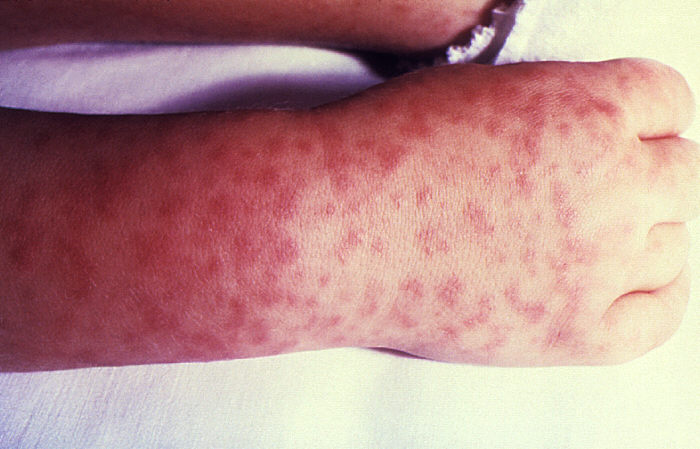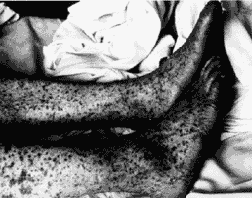Taxonomy
Kingdom: Bacteria
Phylum: Proteobacteria
Class: Alpha Proteobacteria
Order: Rickettsiales
Family: Rickettsiaceae
Genus: Rickettsia
Species: rickettsii
(Emerging Infection Diseases, 1998)
Characteristic rash of Rocky Mountain Spotted Fever on a child's hand

Photo and text courtesy of the CDC - http://www.lib.uiowa.edu/hardin/md/cdc/1962.html
History
Evolutionary History
Rickettsiae are thought to be an evolutionary ancestor of mitochondria. There is suspicion that this bacteria could be the origin of all eukaryotes. Experiments in the reduction of their genome has shown a possibility that may lead to obligate parasitism of this proteobacteria. The progression of their evolution has been closely linked to the evolution of their tick vectors. (Rudakov et al., 2003)
Discovery of the Pathogen
Howard T. Ricketts was the first to identify the infectious organism that causes Rocky Mountain Spotted Fever. He identified the role of tick vectors, and isolated the bacteria Rickettsia rickettsii that is maintained in a life cycle of ticks and mammals. Rocky Mountain Spotted Fever was first recognized in 1896 in the Snake River Valley of Idaho. This fatal disease affecting hundreds in the area was originally named “black measles” because of the characteristic rash associated with it. It spread throughout the United States in the early 1900s. In order to respond to this outbreak, the Rocky Mountain Laboratory was established in Hamilton, Montana. Today research is still conducted at this location in addition to many others in association with the National Institutes of Health. (CDC, 2005)
Symptoms
Rickettsia is considered to be an acute illness other than the possible loss of critical neurons or amputations as the result of gangrene extremities. (Walker et al., 2003) R. rickettsii is rarely detected early enough due to the incubation period of 5-10 days following a tick bite. It’s very nonspecific in the symptoms at the onset. Initial symptoms may include fever, nausea, vomiting, muscle pain, lack of appetite, and severe headache. Later symptoms involve a characteristic rash, abdominal pain, joint pain, and diarrhea. These symptoms can become very severe and most of the patients infected require hospitalization. (CDC, 2005)

Characteristic rash of late-stage Rocky Mountain spotted fever on legs of a patient, ca. 1946 (photo provided courtesy of Rocky Mountain Laboratories, NIAID, NIH, Hamilton, Montana)
Photo and text courtesy of the CDC - http://www.cdc.gov/ncidod/dvrd/rmsf/index.htm
Treatment
There has been a great difficulty in treating rickettsial infections due the high percentage of misdiagnoses in many patients. When proper diagnoses are finally given, the change in the treatment of ineffective beta-lactamases, aminoglycosides, and macrolides to the drug, doxycycline, but is often administered to late in the course of the infection. In addition, there are also several rickettsial species that are resistant to tetracyclines and chloramphenicol have been obtained in laboratory experiments and are relatively easy to develop with genetic manipulations. There is great risk that if R.rickettsii was made resistant to antirickettsial drugs, a low dose inhaled would result in a 25 percent fatality rate. ( Walker, 2006)
When doxycycline is given to a patient, it should be given in doses of 100 mg every 12 hours for adults or 4 mg/kg body weight per day in two divided doses for children under 45 kg. Patients should be treated for a minimum of 3 days after the fever is gone and until improvement is visible. (CDC, 2005)
Prevention
There is an extremely diverse field of research attempting to explore many different preventative methods against the infection of R. rickettsii, most notably the attempt to develop a vaccine. More details about vaccine possibilities can be found on the Future Experiments page.
The only other preventative techniques include limiting one’s exposure to ticks in order to reduce the likelihood of being bitten by one. If exposed to tick habitats, one should examine the area and the body, and immediately remove any crawling or attached ticks because it takes some time to transfer the disease to the host cell. (CDC, 2005)